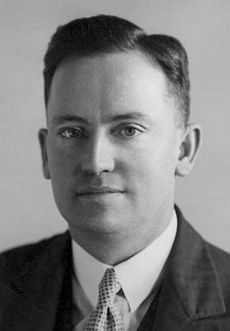Frank Forde facts for kids
Quick facts for kids
Frank Forde
|
|
|---|---|
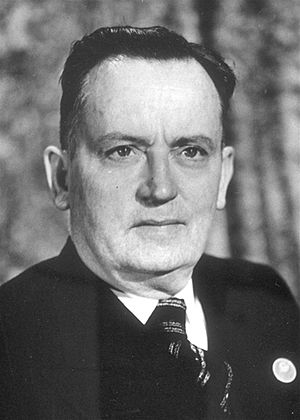
Forde in 1945
|
|
| 15th Prime Minister of Australia | |
| In office 6 July 1945 – 13 July 1945 |
|
| Monarch | George VI |
| Governor-General | Prince Henry, Duke of Gloucester |
| Preceded by | John Curtin |
| Succeeded by | Ben Chifley |
| Deputy Leader of the Labor Party | |
| In office 16 February 1932 – 31 October 1946 |
|
| Leader |
|
| Preceded by | Ted Theodore |
| Succeeded by | H. V. Evatt |
| Member of the Australian Parliament for Capricornia |
|
| In office 16 December 1922 – 28 September 1946 |
|
| Preceded by | William Higgs |
| Succeeded by | Charles Davidson |
| Member of the Queensland Legislative Assembly | |
| In office 12 May 1917 – 5 October 1922 |
|
| Preceded by | John Adamson |
| Succeeded by | George Farrell |
| Constituency | Rockhampton |
| In office 12 March 1955 – 3 August 1957 |
|
| Preceded by | Ernest Riordan |
| Succeeded by | Bill Longeran |
| Constituency | Flinders |
| Personal details | |
| Born |
Francis Michael Forde
18 July 1890 Mitchell, Queensland Colony |
| Died | 28 January 1983 (aged 92) Brisbane, Queensland, Australia |
| Resting place | Toowong Cemetery, Queensland |
| Political party | Labor |
| Spouse |
Veronica O'Reilly
(m. 1925; died 1967) |
| Children | 4 |
| Education | St Mary's College, Toowoomba |
| Occupation | Schoolteacher, telegraphist, politician |
Francis Michael Forde (born 18 July 1890, died 28 January 1983) was an Australian politician. He served as the Prime Minister of Australia for a short time, from 6 to 13 July 1945. This makes him the shortest-serving prime minister in Australia's history.
Forde was also the deputy leader of the Australian Labor Party (ALP) from 1932 to 1946. He became prime minister in a temporary role after the death of John Curtin, who was the leader before him.
Born in Mitchell, Queensland, Forde started his career as a schoolteacher and telegraphist. He joined the Labor Party when he was young. He was first elected to the Queensland Legislative Assembly in 1917, at age 26. Later, he moved to federal politics, winning a seat in the Australian House of Representatives in 1922.
Forde held several important roles in government. He was a minister in the Scullin Government from 1929 to 1932. He then became the Minister for Trade and Customs. After a big election loss in 1931, Forde was chosen as the Labor Party's deputy leader.
When John Curtin died in 1945, Forde stepped in as prime minister. However, the Labor Party then chose a new leader, Ben Chifley. Forde continued as deputy leader and Minister for the Army. He lost his seat in the 1946 election. Later, he served as Australia's representative in Canada. He even returned to state politics in Queensland for a short time.
Contents
Early Life and Career
Frank Forde was born in Mitchell, Queensland, on 18 July 1890. He was the second of six children. His parents, Ellen and John Forde, had moved to Australia from Ireland. His father worked as a grazier and later as a railway supervisor.
Forde went to school locally and then boarded at St Mary's College, Toowoomba. He became a schoolteacher. At age 20, he started working for Queensland Railways in the telegraphy department. He later moved to Brisbane to work as a telegraphist. While there, he also studied electrical engineering.
In 1914, Forde moved to Rockhampton. He became involved in local groups like the Australian Natives' Association and the Australian Workers' Union. He also helped campaign against conscription during World War I.
Starting in Politics
Forde joined the Labor Party in 1915. A state politician named James Larcombe encouraged him and became his mentor. In 1917, at just 26 years old, Forde won a special election for the seat of Rockhampton in the Queensland Legislative Assembly. He was re-elected in 1918 and 1920.
In 1922, Forde decided to try for federal parliament. He resigned from his state seat to run in the Division of Capricornia at the 1922 federal election. He won, defeating the current politician, William Higgs. Forde was 32 when he entered the Australian House of Representatives. He quickly became known for supporting the sugar and cotton industries.
Working in the Scullin Government
The Labor Party won the 1929 election, and James Scullin became prime minister. Forde was chosen to be an assistant minister. He also joined the Committee of Public Accounts. He worked under James Fenton, who was the Minister for Trade and Customs.
Forde often took charge of the Department of Trade and Customs when Fenton was away. He also helped the Minister for Markets and Transport. Forde supported the growing Australian film industry. He even helped reduce taxes on imported sound equipment for movies.
Forde was a key person in the Scullin Government's plan to use high taxes on imported goods, called tariffs. This was meant to help Australian industries during the Great Depression. However, these measures did not greatly improve the economy.
When some ministers resigned in 1931, Forde was elected to fill one of the empty spots. He became the Minister for Trade and Customs. In the 1931 election, the Labor Party lost many seats. But in Forde's home state of Queensland, the party actually gained more seats.
Time in Opposition
After the 1931 election, the Labor Party's deputy leader, Ted Theodore, lost his seat. On 16 February 1932, Forde was elected as the new deputy leader. This made him the Deputy Leader of the Opposition.
Because the leader, James Scullin, was often unwell, Forde frequently acted as the leader of the opposition. When Scullin retired in 1935, Forde ran for the leadership. However, he lost to John Curtin by just one vote. Many people were surprised by this result. Some thought Forde was too closely linked to the previous government's actions.
In 1940, Forde was one of three Labor politicians chosen for the Advisory War Council. This council included members from both major parties and helped guide Australia during World War II.
Serving in the Curtin Government
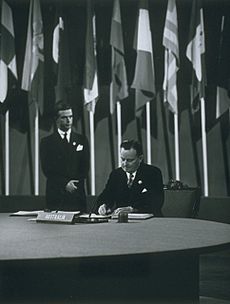
Forde was a loyal deputy to John Curtin. When Labor came back to power in 1941, Forde became the Minister for the Army. This was a very important job during wartime. He was also the unofficial Deputy Prime Minister.
Forde led the Australian War Cabinet and Advisory War Council when Curtin was sick or away. He also acted as prime minister several times. He strongly disagreed with the "Brisbane Line" idea, which suggested pulling troops back from northern Australia if Japan invaded.
Becoming Prime Minister

In April 1945, Forde went to San Francisco for the United Nations Conference on International Organization. While he was away, Prime Minister Curtin became very ill. Ben Chifley became the acting prime minister.
Forde returned to Australia on 2 July and immediately took over from Chifley. Curtin's health had gotten much worse. Curtin died in his sleep on 5 July, at age 60.
On the day Curtin died, Forde announced the news. The next day, 6 July, he led politicians past Curtin's coffin at Old Parliament House, Canberra. Later that day, Forde was officially sworn in as prime minister by the Governor-General of Australia, Prince Henry, Duke of Gloucester.
Forde was appointed prime minister with the understanding that he would step down if the Labor Party chose someone else as leader. He was the Labor Party's sixth prime minister. He is the only Australian prime minister who has never led a political party.
On 8 July, Forde went to Perth for Curtin's funeral. Two days later, Ben Chifley told Forde he would run for the leadership. Norman Makin also decided to run. On 12 July, Forde learned he did not have enough votes to win. Chifley won the leadership vote with 45 votes, while Forde received 16. Forde resigned as prime minister on 13 July, after serving for just one week. He is Australia's shortest-serving prime minister.
After Being Prime Minister
After losing the leadership to Chifley, Forde was re-elected as deputy leader without opposition. He remained Minister for the Army and Minister for Defence. When World War II ended on 15 August, Forde's main job was to manage the process of bringing Australian soldiers home.
This process was not popular with the public. Forde was criticized for not releasing servicemen early enough. He also made public statements about the speed of demobilisation that turned out to be wrong.
In the 1946 election, Forde unexpectedly lost his seat to Charles Davidson, a soldier who had returned from the war. Forde lost by a large margin. People were concerned about the demobilisation issues. He had also moved his family to Sydney during the war, and his local area was suffering from a severe drought.
High Commissioner to Canada
In November 1946, Forde was appointed as the new High Commissioner to Canada. This meant he would represent Australia in Canada. He and his family left Australia in December and arrived in Ottawa in January 1947. He served in this role for six years, returning to Australia in July 1953.
Later Life and Legacy
After returning to Australia, Forde was welcomed in Brisbane. He was asked to return to federal politics but was unsuccessful in the 1954 election.
In 1955, Forde returned to the Queensland Parliament. He won a special election for the seat of Flinders. He is the only former prime minister to have served in a state parliament after being prime minister.
In the 1957 Queensland state election, Forde lost his seat by just one vote. He challenged the result, and a new election was held, but he lost again.
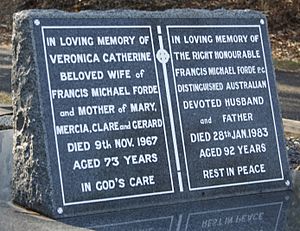
Forde retired to Brisbane and focused on charity work for the Catholic Church. He died in 1983 at the age of 92. He was given a state funeral. Forde was the last surviving member of the governments he served in. He was also the last surviving politician from when Stanley Bruce was Prime Minister.
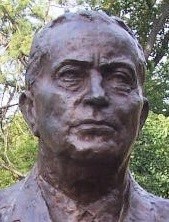
The federal electoral Division of Forde and the Canberra suburb of Forde are named after him.
Family Life
Frank Forde married Veronica (Vera) Catherine O'Reilly in 1925. They had four children:
- Mary Therese (1927–2016)
- Mercia (born 1930)
- Clare (1932–2010)
- Francis Gerard Forde (1935–1966)
Forde's wife, Vera, passed away in November 1967. While he was High Commissioner in Canada, two of his daughters married Canadians. Mary settled in Canada, while Mercia returned to Australia. His son, Francis Gerard Forde, also settled in Australia. His daughter Clare settled in Canberra. Frank and Vera Forde had 15 grandchildren.
Images for kids
See also
 In Spanish: Frank Forde para niños
In Spanish: Frank Forde para niños
- Forde Ministry



